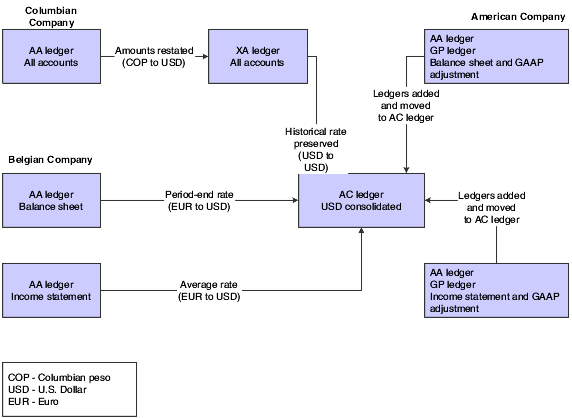23 Understanding Currency Restatement Methods
This chapter contains the following topics:
23.1 Currency Restatement Methods
Most organizations that use multiple currencies perform some method of restatement at the end of each period. Currency restatement is typically used to convert financial information into the currency of a parent company or into a stable currency for consolidations and reporting purposes. With currency restatement, you can restate amounts into:
-
A different currency at the transaction level. This is called detailed currency restatement and is useful for you if the company is operating in highly inflationary economy because it enables you to maintain a second set of transactions in a stable currency for reporting purposes.
-
A different currency at the balance level. This is called balance restatement and is useful for restating balance amounts into another currency that is used for reporting purposes.
-
The same currency using an exchange rate associated with a specific date, as if that rate and date applied to all transactions. This is called as if currency restatement and it eliminates fluctuations in exchange rates over a period of time for comparison purposes.
Note:
Indexed allocations enable you to restate amounts from one currency to another for consolidated reporting; however, you should use one of the currency restatement methods instead of allocations. Rounding problems occur when you use indexed allocations to convert and restate amounts.
Before you set up companies for currency restatement, determine which method you use for reporting and governmental requirements.
Currency restatement involves recalculating amounts from one currency to another currency. The primary objective is to produce consolidated reporting across companies and currencies. If you are not required to produce consolidated reports, you might not have to set up the system for currency restatement.
The JD Edwards EnterpriseOne Multicurrency Processing system provides three currency restatement methods. You can use one, two, or all three methods for a company, as described in this table:
23.1.1 Example: Currency Restatement
This diagram shows a consolidation of three companies that operate in different parts of the world:
Figure 23-1 Example of currency restatement for multiple currencies

Description of ''Figure 23-1 Example of currency restatement for multiple currencies''
The Colombian company, which operates in a highly inflationary economy, uses detailed currency restatement. The American and Belgian companies use balance currency restatement. In this example, GP is a user-defined ledger type for Generally Accepted Accounting Principles (GAAP) adjustments.